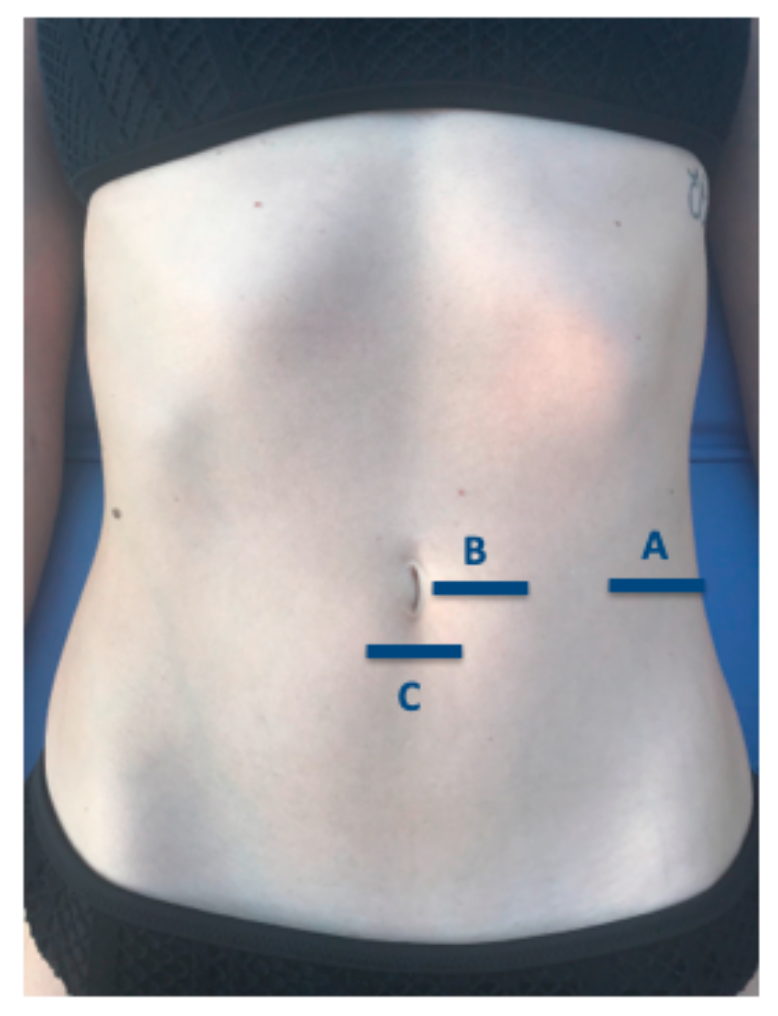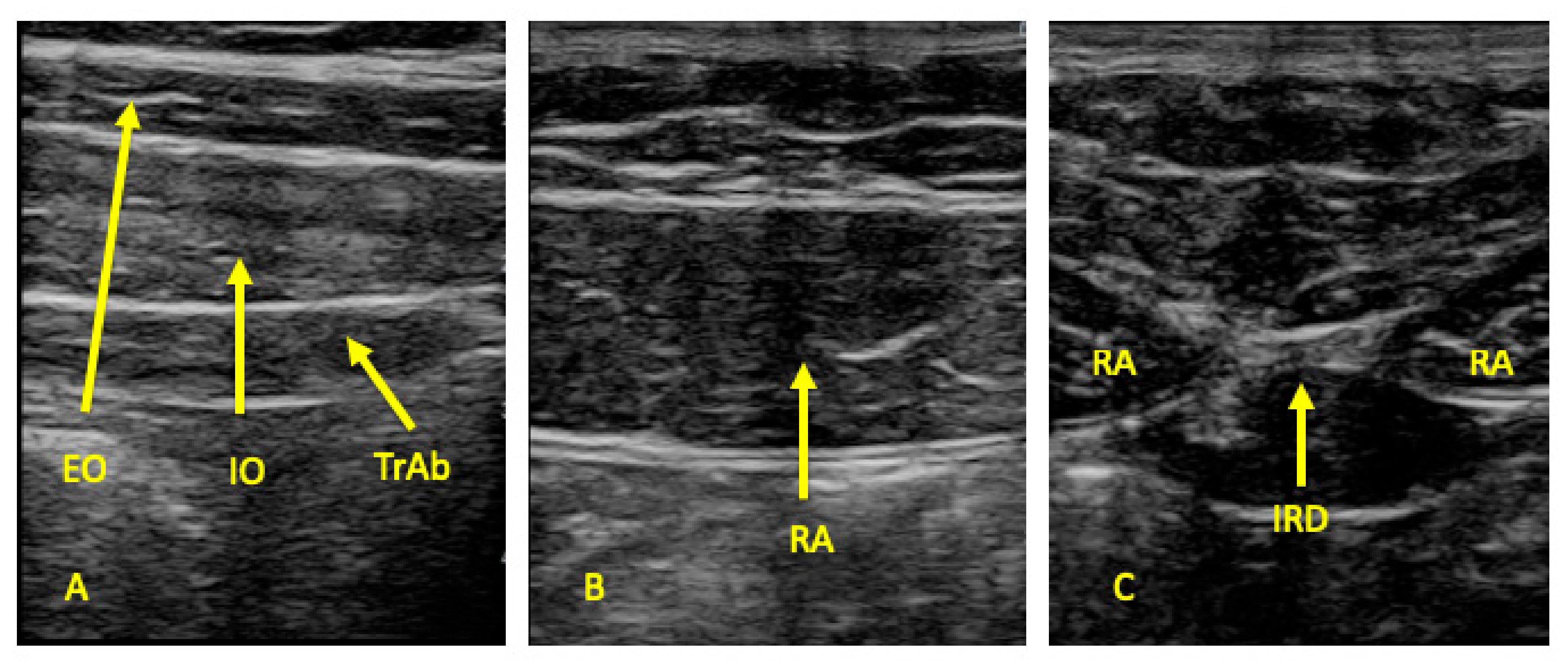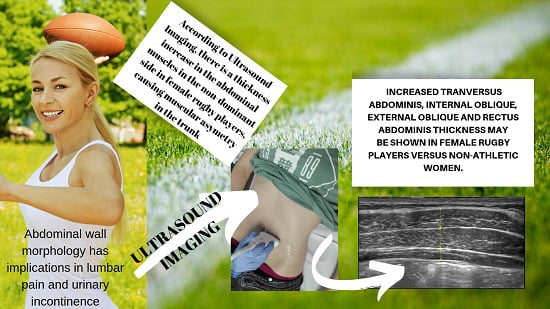Comparison of the Abdominal Wall Muscle Thickness in Female Rugby Players Versus Non-Athletic Women: A Cross-Sectional Study
Abstract
1. Introduction
2. Materials and Methods
2.1. Design
2.2. Ethics
2.3. Subjects
2.4. Outcome Measures
2.5. Statistics Analysis
3. Results
4. Discussion
4.1. Clinical Implications
4.2. Limitations and Future Lines
5. Conclusions
Supplementary Materials
Author Contributions
Funding
Conflicts of Interest
References
- Whittaker, J.L.; Warner, M.B.; Stokes, M. Comparison of the Sonographic Features of the Abdominal Wall Muscles and Connective Tissues in Individuals With and Without Lumbopelvic Pain. J. Orthop. Sport Phys. Ther. 2013, 43, 11–19. [Google Scholar] [CrossRef] [PubMed]
- Morales, C.R.; Polo, J.A.; Sanz, D.R.; López, D.L.; González, S.V.; Buría, J.L.A.; Lobo, C.C. Ultrasonography features of abdominal perimuscular connective tissue in elite and amateur basketball players: An observational study. Rev. Assoc. Med. Bras. 2018, 64, 936–941. [Google Scholar] [CrossRef] [PubMed]
- Brown, S.H.M.; Ward, S.R.; Cook, M.S.; Lieber, R.L. Architectural analysis of human abdominal wall muscles: Implications for mechanical function. Spine Phila 1976 2011, 36, 355–362. [Google Scholar] [CrossRef] [PubMed]
- Akram, J.; Matzen, S.H. Rectus abdominis diastasis. J. Plast. Surg. Hand Surg. 2014, 48, 163–169. [Google Scholar] [CrossRef]
- Stensby, J.D.; Baker, J.C.; Fox, M.G. Athletic injuries of the lateral abdominal wall: Review of anatomy and MR imaging appearance. Skeletal. Radiol. 2016, 45, 155–162. [Google Scholar] [CrossRef]
- Primack, S.J. Musculoskeletal ultrasound. The clinician’s perspective. Radiol. Clin. N. Am. 1999, 37, 617–622. [Google Scholar] [CrossRef]
- Potter, C.L.; Cairns, M.C.; Stokes, M. Use of ultrasound imaging by physiotherapists: A pilot study to survey use, skills and training. Man. Ther. 2012, 17, 39–46. [Google Scholar] [CrossRef]
- Whittaker, J.L.; Stokes, M. Ultrasound Imaging and Muscle Function. J. Orthop. Sport Phys. Ther. 2011, 41, 572–580. [Google Scholar] [CrossRef]
- Juul-Kristensen, B.; Bojsen-Møller, F.; Holst, E.; Ekdahl, C. Comparison of muscle sizes and moment arms of two rotator cuff muscles measured by Ultrasonography and Magnetic Resonance Imaging. Eur. J. Ultrasound. 2000, 11, 161–173. [Google Scholar] [CrossRef]
- Delaney, S.; Worsley, P.; Warner, M.; Taylor, M.; Stokes, M. Assessing contractile ability of the quadriceps muscle using ultrasound imaging. Muscle Nerve 2010, 42, 530–538. [Google Scholar] [CrossRef]
- Bemben, M.G. Use of diagnostic ultrasound for assessing muscle size. J. Strength Cond. Res. 2002, 16, 103–108. [Google Scholar] [PubMed]
- Hides, J.; Wilson, S.; Stanton, W.; McMahon, S.; Keto, H.; McMahon, K.; Bryant, M.; Richardson, C. An MRI investigation into the function of the transversus abdominis muscle during “drawing-in” of the abdominal wall. Spine Phila 1976 2006, 31, E175–E178. [Google Scholar] [CrossRef] [PubMed]
- Coldron, Y.; Stokes, M.J.; Newham, D.J.; Cook, K. Postpartum characteristics of rectus abdominis on ultrasound imaging. Man Ther. 2008, 13, 112–121. [Google Scholar] [CrossRef] [PubMed]
- Lee, J.P.; Tseng, W.Y.I.; Shau, Y.W.; Wang, C.L.; Wang, H.K.; Wang, S.F. Measurement of segmental cervical multifidus contraction by ultrasonography in asymptomatic adults. Man Ther. 2007, 12, 286–294. [Google Scholar] [CrossRef] [PubMed]
- Calvo-Lobo, C.; Almazán-Polo, J.; Becerro-de-Bengoa-Vallejo, R.; Losa-Iglesias, M.E.; Palomo-López, P.; Rodríguez-Sanz, D.; López-López, D. Ultrasonography comparison of diaphragm thickness and excursion between athletes with and without lumbopelvic pain. Phys. Ther. Sport 2019, 37, 128–137. [Google Scholar] [CrossRef]
- O’Sullivan, C.; Meaney, J.; Boyle, G.; Gormley, J.; Stokes, M. The validity of Rehabilitative Ultrasound Imaging for measurement of trapezius muscle thickness. Man Ther. 2009, 14, 572–578. [Google Scholar] [CrossRef]
- Lobo, C.C.; Morales, C.R.; Sanz, D.R.; Corbalán, I.S.; Marín, A.G.; López, D.L. Ultrasonography Comparison of Peroneus Muscle Cross-sectional Area in Subjects With or Without Lateral Ankle Sprains. J. Manipulative Physiol. Ther. 2016, 39, 635–644. [Google Scholar] [CrossRef]
- Romero-Morales, C.; Martín-Llantino, P.J.; Calvo-Lobo, C.; Sánchez-Gómez, R.; López-López, D.; Pareja-Galeano, H.; Rodríguez-Sanz, D. Ultrasound evaluation of extrinsic foot muscles in patients with chronic non-insertional Achilles tendinopathy: A case-control study. Phys. Ther. Sport 2019, 37, 44–48. [Google Scholar] [CrossRef]
- Calvo-Lobo, C.; Useros-Olmo, A.I.; Almazan-Polo, J.; Becerro-de-Bengoa-Vallejo, R.; Losa-Iglesias, M.E.; Palomo-Lopez, P.; Rodríguez-Sanz, D.; López-López, D. Rehabilitative ultrasound imaging of the bilateral intrinsic plantar muscles and fascia in post-stroke survivors with hemiparesis: A case-control study. Int. J. Med. Sci. 2018, 15, 907–914. [Google Scholar] [CrossRef]
- Lobo, C.C.; Marín, A.G.; Sanz, D.R.; López, D.L.; López, P.P.; Morales, C.R.; Corbalán, I.S. Ultrasound evaluation of intrinsic plantar muscles and fascia in hallux valgus: A case-control study. Medicine 2016, 95, e5243. [Google Scholar] [CrossRef]
- Mendis, M.D.; Wilson, S.J.; Stanton, W.; Hides, J.A. Validity of Real-Time Ultrasound Imaging to Measure Anterior Hip Muscle Size: A Comparison with Magnetic Resonance Imaging. J. Orthop. Sport Phys. Ther. 2010, 40, 577–581. [Google Scholar] [CrossRef] [PubMed]
- Rath, A.; Attali, P.; Dumas, J.; Goldlust, D.; Zhang, J.; Chevrel, J. The abdominal linea alba: An anatomo-radiologic and biomechanical study. Surg. Radiol. Anat. 1996, 18, 281–288. [Google Scholar] [CrossRef] [PubMed]
- Teyhen, D.S.; Gill, N.W.; Whittaker, J.L.; Henry, S.M.; Hides, J.A.; Hodges, P. Rehabilitative ultrasound imaging of the abdominal muscles. J. Orthop. Sports Phys. Ther. 2007, 37, 450–466. [Google Scholar] [CrossRef] [PubMed]
- De Almeida Mendes, D.; Xerfan Nahas, F.; Francescato Veiga, D.; Vilela Mendes, F.; Góes Figueiras, R.; Carvalho Gomes, H.; Bins Ely, P.; Ferreira Novo, N.; Masako Ferreira, L. Ultra-sonografia para medir a diástase dos músculos retos do abdome. Acta Cirúrgica Brasileira 2007, 22, 182–186. [Google Scholar]
- Mota, P.; Pascoal, A.G.; Sancho, F.; Bø, K. Test-Retest and Intrarater Reliability of 2-Dimensional Ultrasound Measurements of Distance Between Rectus Abdominis in Women. J. Orthop. Sport Phys. Ther. 2012, 42, 940–946. [Google Scholar] [CrossRef]
- Wachi, M.; Suga, T.; Higuchi, T.; Misaki, J.; Tsuchikane, R.; Tanaka, D.; Miyake, Y.; Kanazawa, N.; Isaka, T. Applicability of ultrasonography for evaluating trunk muscles size in athletes: A study focused on baseball batters. J. Phys. Ther. Sci. 2017, 29, 1534–1538. [Google Scholar] [CrossRef][Green Version]
- Springer, B.A.; Mielcarek, B.J.; Nesfield, T.K.; Teyhen, D.S. Relationships among lateral abdominal muscles, gender, body mass index, and hand dominance. J. Orthop. Sports Phys. Ther. 2006, 36, 289–297. [Google Scholar] [CrossRef]
- Rankin, G.; Stokes, M.; Newham, D.J. Abdominal muscle size and symmetry in normal subjects. Muscle Nerve 2006, 34, 320–326. [Google Scholar] [CrossRef]
- Beer, G.M.; Schuster, A.; Seifert, B.; Manestar, M.; Mihic-Probst, D.; Weber, S.A. The normal width of the linea alba in nulliparous women. Clin. Anat. 2009, 22, 706–711. [Google Scholar] [CrossRef]
- Mota, P.; Pascoal, A.G.; Carita, A.I.; Bø, K. Normal width of the inter-recti distance in pregnant and postpartum primiparous women. Musculoskelet Sci. Pract. 2018, 35, 34–37. [Google Scholar] [CrossRef]
- Pedret, C.; Balius, R.; Pacheco, S.; Gutierrez, J.A.; Escoda, J.; Vives, J. Rectus abdominis muscle injuries in elite handball players: Management and rehabilitation. Open Access J. Sport Med. 2011, 2, 69. [Google Scholar] [CrossRef] [PubMed]
- Aginsky, K.D.; Gray, J.; Vaughan, C.L.; Derman, W.; Hodges, P.W. Symmetry, not asymmetry, of abdominal muscle morphology is associated with low back pain in cricket fast bowlers. J. Sci. Med. Sport 2015, 19, 222–226. [Google Scholar]
- Whittaker, J.L.; Emery, C.A. Impact of the FIFA 11+ on the structure of select muscles in adolescent female soccer players. Phys. Ther. Sport 2015, 16, 228–235. [Google Scholar] [CrossRef] [PubMed]
- Almazán-Polo, J.; Romero-Morales, C.; Vázquez-González, S.; López-López, D.; Rodríguez-Sanz, D.; Palomo-López, P.; Calvo-Lobo, C. Rehabilitative Ultrasound Imaging Features of the Abdominal Wall Muscles in Elite and Amateur Basketball Players. Appl. Sci. 2018, 8, 809. [Google Scholar]
- Sanchis-Moysi, J.; Idoate, F.; Dorado, C.; Alayón, S.; Calbet, J.A.L. Large Asymmetric Hypertrophy of Rectus Abdominis Muscle in Professional Tennis Players. Lucia A, editor. PLoS ONE 2010, 5, e15858. [Google Scholar] [CrossRef][Green Version]
- Gala-Alarcón, P.; Calvo-Lobo, C.; Serrano-Imedio, A.; Garrido-Marín, A.; Martín-Casas, P.; Plaza-Manzano, G. Ultrasound Evaluation of the Abdominal Wall and Lumbar Multifidus Muscles in Participants Who Practice Pilates: A 1-year Follow-up Case Series. J. Manip. Physiol. Ther. 2018, 41, 434–444. [Google Scholar] [CrossRef]
- Jones, B.; Emmonds, S.; Hind, K.; Nicholson, G.; Rutherford, Z.; Till, K. Physical Qualities of International Female Rugby League Players by Playing Position. J. Strength Cond. Res. 2016, 30, 1333–1340. [Google Scholar] [CrossRef]
- Hodges, P.W.; Richardson, C.A. Contraction of the abdominal muscles associated with movement of the lower limb. Phys. Ther. 1997, 77, 132–134. [Google Scholar] [CrossRef]
- Neumann, P.; Gill, V. Pelvic floor and abdominal muscle interaction: EMG activity and intra-abdominal pressure. Int. Urogynecol. J. Pelvic. Floor Dysfunct. 2002, 13, 125–132. [Google Scholar] [CrossRef]
- Hides, J.; Stanton, W.; Freke, M.; Wilson, S.; McMahon, S.; Richardson, C. MRI study of the size, symmetry and function of the trunk muscles among elite cricketers with and without low back pain. Br. J. Sports Med. 2008, 42, 509–513. [Google Scholar] [CrossRef]
- Keshwani, N.; McLean, L. Ultrasound Imaging in Postpartum Women With Diastasis Recti: Intrarater Between-Session Reliability. J. Orthop. Sports Phys. Ther. 2015, 45, 713–718. [Google Scholar] [CrossRef] [PubMed]
- Joueidi, Y.; Vieillefosse, S.; Cardaillac, C.; Mortier, A.; Oppenheimer, A.; Deffieux, X.; Thubert, T. Impact of the diastasis of the rectus abdominis muscles on the pelvic-perineal symptoms: Review of the literature. Prog. Urol. 2019, 29, 544–559. [Google Scholar] [CrossRef] [PubMed]
- Benjamin, D.R.; Frawley, H.C.; Shields, N.; van de Water, A.T.M.; Taylor, N.F. Relationship between diastasis of the rectus abdominis muscle (DRAM) and musculoskeletal dysfunctions, pain and quality of life: A systematic review. Physiotherapy 2019, 105, 24–34. [Google Scholar] [CrossRef] [PubMed]
- De Mattos Lourenco, T.R.; Matsuoka, P.K.; Baracat, E.C.; Haddad, J.M. Urinary incontinence in female athletes: A systematic review. Int. Urogynecol. J. 2018, 29, 1757–1763. [Google Scholar] [CrossRef] [PubMed]
- Von Elm, E.; Altman, D.G.; Egger, M.; Pocock, S.J.; Gøtzsche, P.C.; Vandenbroucke, J.P. The Strengthening the Reporting of Observational Studies in Epidemiology (STROBE) statement: Guidelines for reporting observational studies. J. Clin. Epidemiol. 2008, 61, 344–349. [Google Scholar] [CrossRef] [PubMed]
- Chiarello, C.M.; McAuley, J.A. Concurrent Validity of Calipers and Ultrasound Imaging to Measure Interrecti Distance. J. Orthop. Sport Phys. Ther. 2013, 43, 495–503. [Google Scholar] [CrossRef] [PubMed]
- Whittaker, J.L. Ultrasound imaging of the lateral abdominal wall muscles in individuals with lumbopelvic pain and signs of concurrent hypocapnia. Man Ther. 2008, 13, 404–410. [Google Scholar] [CrossRef]
- Gillard, S.; Ryan, C.G.; Stokes, M.; Warner, M.; Dixon, J. Effects of posture and anatomical location on inter-recti distance measured using ultrasound imaging in parous women. Musculoskelet Sci. Pract. 2018, 34, 1–7. [Google Scholar] [CrossRef]
- Jhu, J.L.; Chai, H.M.; Jan, M.H.; Wang, C.L.; Shau, Y.W.; Wang, S.F. Reliability and Relationship Between 2 Measurements of Transversus Abdominis Dimension Taken During an Abdominal Drawing-in Maneuver Using a Novel Approach of Ultrasound Imaging. J. Orthop. Sport Phys. Ther. 2012, 40, 826–832. [Google Scholar] [CrossRef]
- Schneider, C.A.; Rasband, W.S.; Eliceiri, K.W. NIH Image to ImageJ: 25 years of image analysis. Nat. Methods 2012, 9, 671. [Google Scholar] [CrossRef]
- Leppink, J.; O’Sullivan, P.; Winston, K. Effect size—Large, medium, and small. Perspect Med. Educ. 2016, 5, 347–349. [Google Scholar] [CrossRef] [PubMed]
- Teyhen, D.S.; Rieger, J.L.; Westrick, R.B.; Miller, A.C.; Molloy, J.M.; Childs, J.D. Changes in deep abdominal muscle thickness during common trunk-strengthening exercises using ultrasound imaging. J. Orthop. Sports Phys. Ther. 2008, 38, 596–605. [Google Scholar] [CrossRef] [PubMed]
- Kubo, T.; Muramatsu, M.; Hoshikawa, Y.; Kanehisa, H. Profiles of Trunk and Thigh Muscularity in Youth and Professional Soccer Players. J. Strength Cond. Res. 2010, 24, 1472–1479. [Google Scholar] [CrossRef] [PubMed]
- Connell, D.; Ali, K.; Javid, M.; Bell, P.; Batt, M.; Kemp, S. Sonography and MRI of Rectus Abdominis Muscle Strain in Elite Tennis Players. Am. J. Roentgenol. 2006, 187, 1457–1461. [Google Scholar] [CrossRef] [PubMed]
- Balius, R.; Pedret, C.; Galilea, P.; Idoate, F.; Ruiz-Cotorro, A. Ultrasound assessment of asymmetric hypertrophy of the rectus abdominis muscle and prevalence of associated injury in professional tennis players. Skeletal. Radiol. 2012, 41, 1575–1581. [Google Scholar] [CrossRef] [PubMed]
- Seminati, E.; Cazzola, D.; Preatoni, E.; Trewartha, G. Specific tackling situations affect the biomechanical demands experienced by rugby union players. Sport Biomech. 2017, 16, 58–75. [Google Scholar] [CrossRef] [PubMed]
- Sapsford, R.R.; Hodges, P.W.; Richardson, C.A.; Cooper, D.H.; Markwell, S.J.; Jull, G.A. Co-activation of the abdominal and pelvic floor muscles during voluntary exercises. Neurourol. Urodyn. 2001, 20, 31–42. [Google Scholar] [CrossRef]
- Junginger, B.; Baessler, K.; Sapsford, R.; Hodges, P.W. Effect of abdominal and pelvic floor tasks on muscle activity, abdominal pressure and bladder neck. Int. Urogynecol. J. 2010, 21, 69–77. [Google Scholar] [CrossRef]
- Lee, D.; Hodges, P.W. Behavior of the Linea Alba During a Curl-up Task in Diastasis Rectus Abdominis: An Observational Study. J. Orthop. Sports Phys. Ther. 2016, 46, 580–589. [Google Scholar] [CrossRef]


| Data | Rugby (n = 16) | Controls (n = 16) | p-Value Cases vs. Controls |
|---|---|---|---|
| Age, y | 24.73 (4.90) * | 27.93 (6.13) * | 0.127 ** |
| Weight, kg | 61.0 (60.0–69.0) † | 61.50 (53.0–70.0) † | 0.285 ‡ |
| Height, m | 1.65 (1.63–1.69) † | 1.64 ± (1.58–1.69) † | 0.389 ‡ |
| BMI, kg/m2 | 23.44 (21.9–24.7) † | 22.79 (20.5–25.7) † | 0.412 ‡ |
| Measurement | Rugby (n = 16) | Controls (n = 16) | p-Value |
|---|---|---|---|
| Distance (cm) | |||
| IRD | 0.44 (0.13) * | 0.44 (0.37–0.60) † | 0.367 ‡ |
| Thickness (cm) | |||
| Right TrAb | 0.41 (1.06–1.03) † | 0.33 (0.07) * | 0.011 ‡ |
| Right IO | 0.93 ± 0.07 * | 0.80 ± 0.12 * | 0.003 ** |
| Right EO | 0.73 ± 0.13 * | 0.64 ± 0.11 * | 0.045 ** |
| Right RA | 1.19 ± 0.12 * | 1.03 ± 0.11 * | 0.001 ** |
© 2019 by the authors. Licensee MDPI, Basel, Switzerland. This article is an open access article distributed under the terms and conditions of the Creative Commons Attribution (CC BY) license (http://creativecommons.org/licenses/by/4.0/).
Share and Cite
Abuín-Porras, V.; de la Cueva-Reguera, M.; Benavides-Morales, P.; Ávila-Pérez, R.; de la Cruz-Torres, B.; Pareja-Galeano, H.; Blanco-Morales, M.; Romero-Morales, C. Comparison of the Abdominal Wall Muscle Thickness in Female Rugby Players Versus Non-Athletic Women: A Cross-Sectional Study. Medicina 2020, 56, 8. https://doi.org/10.3390/medicina56010008
Abuín-Porras V, de la Cueva-Reguera M, Benavides-Morales P, Ávila-Pérez R, de la Cruz-Torres B, Pareja-Galeano H, Blanco-Morales M, Romero-Morales C. Comparison of the Abdominal Wall Muscle Thickness in Female Rugby Players Versus Non-Athletic Women: A Cross-Sectional Study. Medicina. 2020; 56(1):8. https://doi.org/10.3390/medicina56010008
Chicago/Turabian StyleAbuín-Porras, Vanesa, Mónica de la Cueva-Reguera, Pedro Benavides-Morales, Rocío Ávila-Pérez, Blanca de la Cruz-Torres, Helios Pareja-Galeano, María Blanco-Morales, and Carlos Romero-Morales. 2020. "Comparison of the Abdominal Wall Muscle Thickness in Female Rugby Players Versus Non-Athletic Women: A Cross-Sectional Study" Medicina 56, no. 1: 8. https://doi.org/10.3390/medicina56010008
APA StyleAbuín-Porras, V., de la Cueva-Reguera, M., Benavides-Morales, P., Ávila-Pérez, R., de la Cruz-Torres, B., Pareja-Galeano, H., Blanco-Morales, M., & Romero-Morales, C. (2020). Comparison of the Abdominal Wall Muscle Thickness in Female Rugby Players Versus Non-Athletic Women: A Cross-Sectional Study. Medicina, 56(1), 8. https://doi.org/10.3390/medicina56010008









